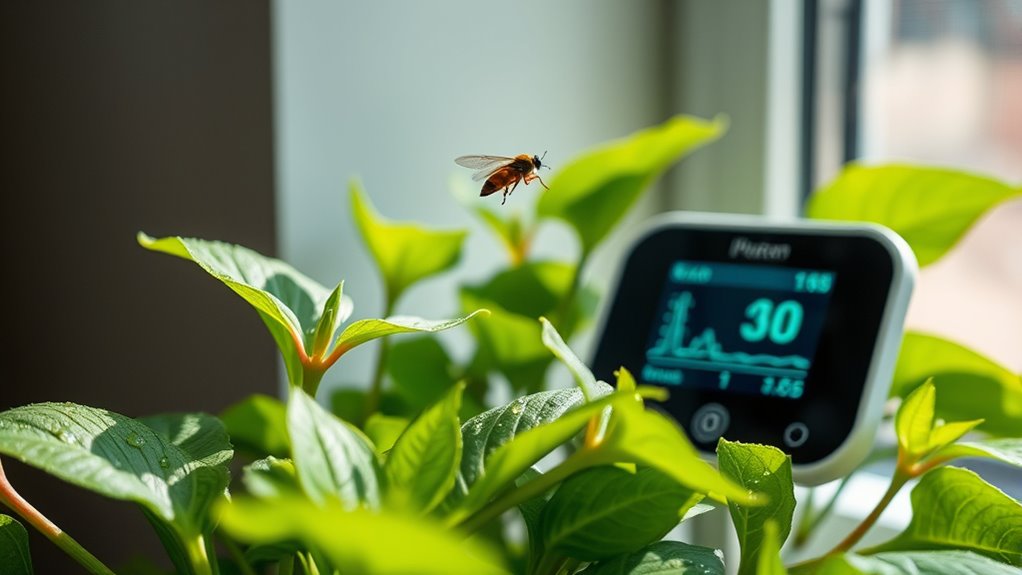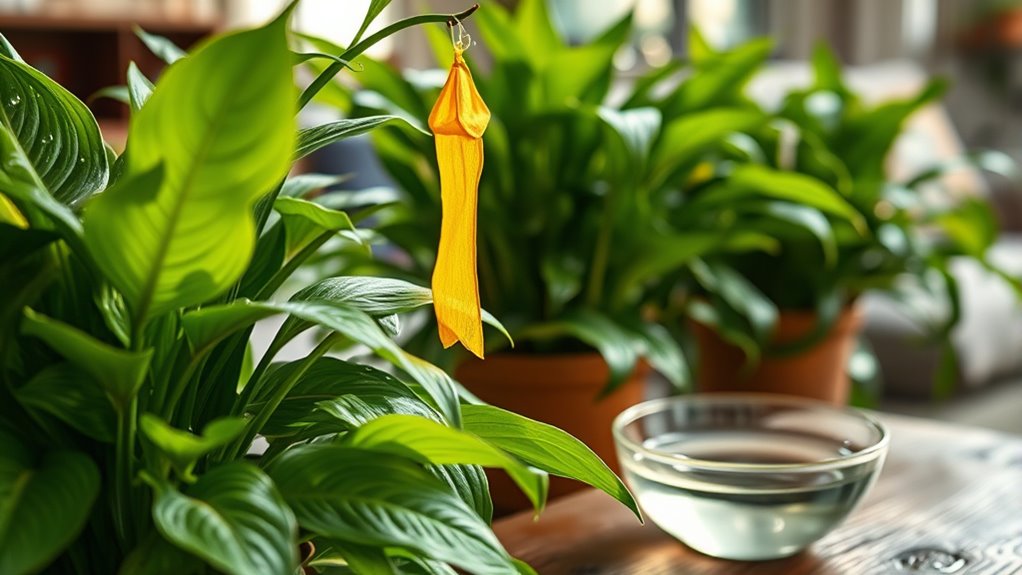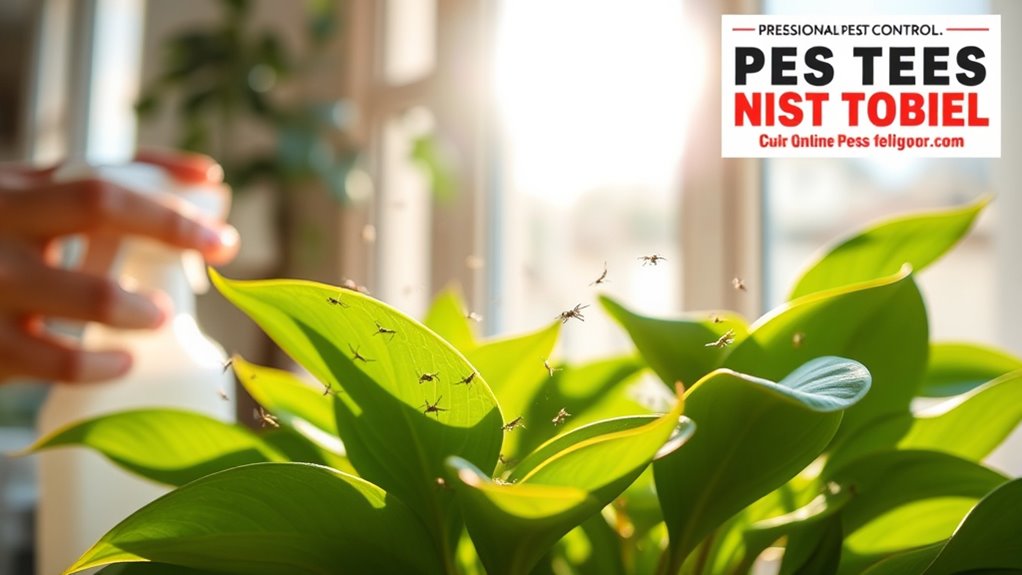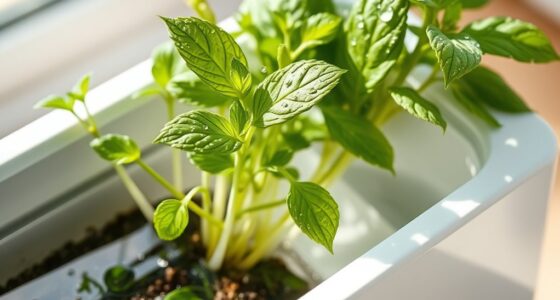To get rid of flying bugs on your indoor plants, start by letting the soil dry out between waterings, as high moisture levels attract these pests. Use yellow sticky traps to monitor for gnats and consider repotting with fresh, gnat-free soil. Natural solutions like neem oil can help disrupt their life cycle. If the problem persists, effective chemical options are available. Keep exploring for more tips on creating a healthy environment for your plants.
Key Takeaways
- Allow the soil to dry out between waterings to disrupt the breeding cycle of flying bugs.
- Use yellow or blue sticky traps to capture and monitor flying insects effectively.
- Implement natural pest control methods, such as introducing beneficial nematodes to target gnat larvae.
- Apply neem oil or pyrethrin sprays to disrupt life cycles and eliminate adult bugs.
- Maintain good air circulation and proper drainage in pots to create an unfavorable environment for pests.
Identifying the Flying Bugs on Your Indoor Plants

How can you tell if those pesky flying bugs on your indoor plants are fungus gnats? First, look for small, dark brown or black flies, about 1/8 inch long, with translucent wings.
These bugs thrive in moist soil, often appearing around overwatered plants. You might notice them flying toward light sources or buzzing near your face. Fungus gnats generally do not harm houseplants or humans, which is a relief for those concerned about their indoor greenery. Additionally, fresh orange juice can attract fruit flies, which can be confused with fungus gnats. To help prevent fungus gnats, ensure that your plants have proper drainage features to avoid waterlogging the soil. Choosing pots made from natural materials can also support healthy plant growth and reduce pest attraction.
Fungus gnats thrive in moist soil, often drawn to overwatered plants and light sources.
To distinguish fungus gnats from similar insects, check for their unique Y-shaped wing vein pattern under a magnifying glass. Remember, they’re smaller than fruit flies, which prefer sweet substances.
To confirm an infestation, try placing raw potato slices on the soil or using yellow sticky traps nearby. This’ll help you identify whether those annoying flies are indeed fungus gnats.
Understanding the Causes of Infestation

While you mightn’t realize it, the conditions in your home play a crucial role in attracting fungus gnats to your indoor plants. High moisture levels in the soil make it a perfect breeding ground for these pests. If you consistently overwater your plants or use potting soil rich in organic matter, you’re creating an inviting environment for gnats. Additionally, plants brought indoors from outside might already be infested. Poor drainage in pots can also trap moisture, further encouraging their growth. Warm indoor temperatures and high humidity only speed up their life cycle. Indoor plants attract bugs due to fragrant, sugary leaves, which can exacerbate the pest problem. Furthermore, the presence of harmful pollutants in indoor air can negatively affect plant health, making them more susceptible to pests. Understanding the importance of long-term financial planning can also help you better manage the stress of dealing with these infestations. Encouraging emotional resilience through mindfulness can also help you better manage the stress of dealing with these infestations.
Monitoring Techniques for Detecting Bugs

To effectively manage flying bugs on your indoor plants, you’ll need to adopt a variety of monitoring techniques.
Start with regular visual inspections to spot pests, eggs, or larvae. Yellow or blue sticky traps work wonders for capturing flying insects like fungus gnats and whiteflies. Implementing consistent daily routines can also help you stay on top of pest management by ensuring you check your plants regularly. Engaging in activities that improve hand-eye coordination can enhance your dexterity when inspecting for pests. Additionally, maintaining optimal air quality can create an environment less conducive to pest infestations.
Regular visual inspections and sticky traps are essential for detecting and capturing flying insects like fungus gnats and whiteflies.
Don’t forget to use magnifying tools to closely examine small pests on your plants. Keeping documentation of pest sightings will help you track trends and identify recurring issues.
For those who want to go high-tech, consider implementing camera traps or even machine vision systems for early detection. Automated image analysis tools can significantly enhance your ability to detect and manage pest populations rapidly.
All these techniques will empower you to spot bugs before they become a bigger problem, ensuring your plants remain healthy and pest-free.
Non-Chemical Control Methods

Effective control of flying bugs on indoor plants can often be achieved through non-chemical methods.
Start by managing your soil; allow it to dry out between waterings to make it inhospitable for gnats. You can also repot your plants in fresh, gnat-free soil. Additionally, be aware that tiny flying bugs are commonly found in potting mixes containing compost and bark, so using a high-quality potting mix can help prevent infestations. Incorporating high-fiber ingredients like chia seeds into your diet can also support overall wellness, making you less susceptible to stress-related pest issues. Additionally, maintaining an ideal soil pH of 6.0 to 7.0 can promote plant health and resilience against pests, particularly because whole foods often enhance nutrient absorption and overall plant vigor.
Sticky traps, like yellow ones, can capture adult gnats effectively. Consider using vinegar traps or sugar and soap mixtures to lure and drown them.
Introducing natural predators, such as beneficial nematodes, can help control larvae populations.
Additionally, adjust your environment by reducing moisture and avoiding overwatering. Using a dehumidifier and isolating new plants can further prevent infestations.
These methods are effective and safe, ensuring your indoor plants thrive without harsh chemicals.
Effective Chemical Control Options

Chemical control options can provide a quick solution for managing flying bugs on your indoor plants.
Pyrethroid insecticides, like bifenthrin and permethrin, are effective against fungus gnats. For immediate contact killing, try pyrethrin sprays, but remember they require frequent applications. Neem oil disrupts the gnat life cycle and can be used as a soil drench or spray. Bacillus thuringiensis israelensis (Bti) targets gnat larvae and is often found in mosquito dunks. Insecticidal soaps and oils are short-term solutions but need repeated applications. Apply these chemicals directly to the soil or as foliar sprays, ensuring you follow label instructions for safety and plant compatibility. Proper ventilation is crucial when using these products indoors, as it helps minimize the concentration of chemicals in the air. Additionally, controlling these pests can be enhanced by allowing the growing medium to dry between waterings, which helps reduce the survival of fungus gnat larvae. Incorporating essential oils into your pest management strategy can provide a natural alternative alongside chemical options. Regular fuel injection cleaning can also improve the overall health of your indoor plants by ensuring they receive the nutrients they need efficiently.
Preventive Measures for Future Infestations

Preventing future infestations of flying bugs on your indoor plants requires a proactive approach that focuses on soil management, watering techniques, and plant care.
Start by choosing potting mixes that don’t contain compost or bark, as these can attract pests. Solarize or heat-treat your soil before use to eliminate potential bugs. Additionally, consider using closed bottom pots as they are more effective in preventing pests like fungus gnats. Maintaining an organized environment can also support emotional well-being by reducing stress related to plant care. Incorporating energy-efficient solutions into your indoor gardening can also promote healthier plants. A well-balanced approach to plant care, including nutrient-rich diets, can enhance the overall health of your indoor plants.
Avoid overwatering and ensure your pots have proper drainage to keep the soil from staying too moist. When watering, use bottom watering techniques and allow the top layer of soil to dry slightly between waterings.
Inspect new plants for pests and isolate them for a month before introducing them to your collection.
Lastly, maintain good air circulation to prevent moisture buildup, which attracts gnats.
Maintaining a Healthy Indoor Plant Environment

Creating a thriving indoor plant environment goes hand in hand with the preventive measures you’ve already taken against pests.
Start by understanding your plants’ light and water needs; most thrive in indirect light and prefer watering when the soil feels dry. Additionally, regular cleaning of the cage can help minimize the risk of pests in your home, as it reduces potential harborage areas for insects. Incorporating chia seeds into your diet can also enhance your overall health, which indirectly supports your ability to care for your plants effectively.
Understanding your plants’ light and water needs is essential; most flourish in indirect light and prefer watering when the soil is dry.
Keep temperatures between 65-75°F (18-24°C) and maintain humidity levels of 40-60% using humidifiers or misting. Houseplants improve indoor air quality by absorbing toxins and serving as natural air purifiers, which further enhances their living environment. Incorporating essential oils for pest control can also deter flying bugs without harming your plants.
Choose high-quality potting mixes tailored to your plants for better drainage and nutrients.
Ensure proper air circulation by spacing plants adequately and using fans if needed.
Regularly check for signs of pests and repot as necessary to refresh the soil.
These steps will help you create a robust environment, minimizing the risk of infestations and keeping your plants healthy.
When to Seek Professional Help

When flying bugs infest your indoor plants, knowing when to seek professional help can save you time and frustration.
If you notice severe infestations affecting multiple plants or if home remedies aren’t working, it’s time to call in the experts. Extensive damage or the presence of various pest types complicates treatment, making professional intervention advisable. Additionally, if you have a large plant collection or face recurring infestations, expert assistance can provide effective solutions. Professionals use specialized equipment and techniques that aren’t available to the average gardener. Furthermore, they can help implement biological control methods that utilize natural solutions to manage pest populations effectively. Seeking professional help for pest control can also ensure that you are taking the right steps to maintain your plants’ health. If you’re busy or lack the necessary expertise, consider hiring a pest control service. They can also offer preventive measures and guidance to keep your plants healthy and pest-free. By working with professionals, you gain access to a supportive community network that can enhance your overall gardening experience. Additionally, experts can offer insights on best practices for plant care to prevent future infestations.
Frequently Asked Questions
Can Fungus Gnats Transmit Diseases to Humans or Pets?
Fungus gnats don’t transmit diseases to humans or pets, so you don’t have to worry about them causing health issues.
They mainly spread plant pathogens, like pythium, affecting your indoor plants. While adult gnats are just a nuisance, their larvae can damage roots.
Keeping your plants healthy and managing soil moisture can prevent infestations, making your indoor gardening experience more enjoyable without the stress of disease transmission.
How Long Do Fungus Gnats Typically Live?
Imagine tiny shadows flitting through your space, those pesky fungus gnats typically live about one to two weeks.
Within this short lifespan, they can lay up to 300 eggs!
After hatching, larvae feast on fungi and plant roots for around 10 to 14 days before transforming into adults.
Understanding their life cycle helps you tackle any potential infestations effectively, ensuring your plants thrive despite these fleeting nuisances.
Do Fungus Gnats Prefer Specific Plant Types?
Yes, fungus gnats do prefer specific plant types.
They’re often found around plants like African violets, geraniums, and cyclamens. These gnats thrive in moist environments, so if you’re watering your plants frequently, you might attract them.
They’re also drawn to decaying organic matter in the soil. By selecting plants that can tolerate drier conditions, you can reduce the likelihood of attracting these pesky insects.
What Time of Year Are Fungus Gnats Most Active?
Fungus gnats are most active during the transitions from winter to spring and summer to fall.
You’ll notice these pests thriving as temperatures rise and moisture levels increase. If you’re bringing houseplants indoors after summer, be wary—those plants can carry infestations.
Their rapid breeding in warm, moist conditions makes these times particularly conducive for fungus gnat populations.
Keeping an eye on your plants during these periods can help you manage any potential issues.
Can Fungus Gnats Affect Indoor Air Quality?
Yes, fungus gnats can affect your indoor air quality.
When you overwater your plants, the excess moisture can lead to mold growth, which may release spores into the air. These spores can trigger allergies and respiratory issues.
Additionally, the gnats themselves can contribute to indoor allergens.
To minimize these effects, make sure you’re not overwatering and keep your plants well-maintained to reduce moisture levels and improve air quality.
Conclusion
By tackling flying bugs on your indoor plants with the right approach, you can reclaim your green sanctuary. Picture your plants thriving, free from pesky pests, basking in sunlight like champions of the indoor jungle. With a mix of vigilance, natural remedies, and a sprinkle of preventative care, you’ll create a harmonious environment that nurtures growth. So, roll up your sleeves, embrace the challenge, and watch your indoor oasis flourish once again!











